May 04
It started off a bit gray and rainy today, and we headed off with the intent of going south on our way towards Hadrian's Wall and the suggested castles (from our Northumbrian friends from yesterday). No real plan today -- just follow the map and see where we end up. (Actually, that's how many of our days go -- get in the car, open the map page, and see what is in range and off we go.)
Flying by the seat of our pants
I suppose I could have been a bit more organized, but part of the joy of traveling is the serendipity of it all. Ending up somewhere you didn't plan to, stumbling across a true gem of a place because you took a wrong turn or decided to head off in the opposite direction today. I know a lot of people who plan their vacations down to he minute and have a rigid itinerary - I think most people plan their travel somewhere in the middle. There' s a lot to be said for the planners, of course -- you can make reservations ahead of time, you are nearly guaranteed not to miss the major things you have planned to see, you probably have more free time or down time in your vacation. The tradeoff, of course, is that you can't switch gears and do something entirely different on a whim without throwing ht plans out of whack. I like the seat-of-your-pants method of travel, myself. No reservations, a vague list of "must-sees" that might change from day to day, depending on who you talk to you r what you pass. It can get a bit nerve-wracking, if you have problems finding a place to stay, but if you travel in the off or shoulder season, there are rarely any problems. We did discover, though, that calling before about 2pm make things a lot easier; waiting until four or five to find a room for the night tended to limit the options!
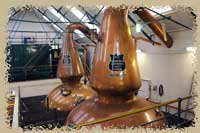 One thing we did have on our list for this trip was "visit more distilleries". Not only are we specifically heading to Speyside to spend some time in the heart of the Whisky Festival in a week or so, we have a specific goal to taste more single malts. As I was plotting our route south, I noticed that the Glenkinchie (glen-kin-chee) Distillery was just a short bit out of our way, so we swung into the parking lot just as they opened . Glenkinchie is a small distillery -- just two stills (compare this to the 16 or more at the large distilleries like Glenlivet and Macallan.) The tour covered the basics of how whisky is made (and it’s the same pretty much everywhere), but the nice part about the tour here was that it was so small and we were allowed to take pictures everywhere except the milling room (where there is a real danger of explosion because of the dust). Most of the larger distilleries, we were to discover, banned photography anywhere on the site.
One thing we did have on our list for this trip was "visit more distilleries". Not only are we specifically heading to Speyside to spend some time in the heart of the Whisky Festival in a week or so, we have a specific goal to taste more single malts. As I was plotting our route south, I noticed that the Glenkinchie (glen-kin-chee) Distillery was just a short bit out of our way, so we swung into the parking lot just as they opened . Glenkinchie is a small distillery -- just two stills (compare this to the 16 or more at the large distilleries like Glenlivet and Macallan.) The tour covered the basics of how whisky is made (and it’s the same pretty much everywhere), but the nice part about the tour here was that it was so small and we were allowed to take pictures everywhere except the milling room (where there is a real danger of explosion because of the dust). Most of the larger distilleries, we were to discover, banned photography anywhere on the site.
Making Single-malt Whisky (without an 'e')
The process for making whisky is actually quite simple - barley, water and yeast are the only ingredients. The barley is malted (that is, sprouted slightly), then dried and ground. The resulting grist is mixed with hot water in a mash tun (a huge barrel, basically) to dissolve the sugars in the barley. The wort -- basically sweetish water at this point -- is drawn off and the process repeated several times with the same barley until the last bit of sugar is dissolved. It's not alcohol at this point -- that requires the addition of yeast to the cooled wort in the wash backs (also giant barrels). A couple of days fermenting and the wort becomes wash, with an alcohol content of 5-10%. It's at this point that distillation begins - the wash is piped into the first of two pot-stills (made of copper) and heated to the evaporation point, where it flows out the top of the still and is condensed in huge cooled coils. The output of the wash still is still too low to be whisky, and is sent to the spirit still, where a second distillation is done - the alcohol produced by the spirit still is new spirits in it's infancy: clear, strong, and just about flavorless.
The output of the spirit still is divided into three 'parts' -- the initial part of distillation is called the foreshots (the 'head') of the run, and it is not pure enough to bottle, it is stored away and reprocessed. The last part of the run (called the 'feints') are also not pure enough to bottle. These are put back into the process and mixed with the wash from the next batch. It is the middle part - the 'heart' -- that is bottled and aged. From there, it's off to the casks for aging. By law, whisky must be aged in oak barrels for a minimum of three years in Scotland. Every distillery has enormous warehouses with casks stacked up to the rafters.
While there are some specific rules that make distilled spirits in Scotland actually 'whisky' (the barrel, the barley, the copper stills, etc) the process is the same for other types of whiskey as well (note the 'e' there -- only in Scotland, and only if they follow the rules properly, is the output called 'whisky'-without-an-e.). Bourbon is roughly the same process, but it is only distilled once. Irish Whiskey is distilled three times (a distinction that they will tell you makes far superior spirits!).
Of course, most of the whisky produced by any distillery in Scotland is used in blended whiskey (Johnny Walker, Chivas, that sort of thing). Only a tiny portion of what they produce is sold as a single-malt whisky. By the way, single-malt doesn't mean that it's only from one barrel or from one 'run' of the still, but that it is whiskey from one distillery. Whisky of different ages may be mixed together to create the final product, but what's important is that it's from the single distillery (the single 'malting' recipe).
We split the 'wee dram' at the end of the trip, since Mark has to drive. The rules do define just how much can be in the tiny taste, by the way - it's barely a smidge, enough to taste and unless you are such a lightweight that walking through the distillery gives you a buzz, you'll be fine.
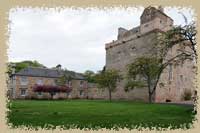 We drove to see the dot labeled 'lennoxlove castle' on my map, and discovered that, like many of the tower houses in the region, it has been incorporated into a large mansion house with big window. Lennoxlove has been restored as a very posh hotel and event center, so we didn't get to wander around inside, but we did get a few pictures of the extremely well-preserved tower house and grounds.
We drove to see the dot labeled 'lennoxlove castle' on my map, and discovered that, like many of the tower houses in the region, it has been incorporated into a large mansion house with big window. Lennoxlove has been restored as a very posh hotel and event center, so we didn't get to wander around inside, but we did get a few pictures of the extremely well-preserved tower house and grounds.
A short mechanical interlude
Mark was far more excited about our next stop - the National Museum of Flight. A huge decommissioned military airbase with hangers full of airplanes in varying states of repair. Definitely not my thing, but the Husband is fascinated and we trekked all over the site looking at the displays. We didn't opt to see the Concorde (in its own hanger and with its own admission fee) because of the huge crowds (Bank Holiday, you know), but the rest of the site is a huge open museum. Mark read just about every single word on every single placard about every single airplane while I wandered around taking 'artsy' photographs of the planes from weird angles to amuse myself.
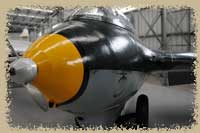 The little café in the Pilot's Lounge was absolutely jam-packed with people and we stood in line for about thirty seconds before deciding that we'd have better luck finding food somewhere else. I wanted to see Dirleton Castle again (it's one of my favorites - it's even the background image for this site) so we drove into town and looked for a quick stop for sandwiches. Easy enough to find, and we even managed to arrive before the rain showed up.
The little café in the Pilot's Lounge was absolutely jam-packed with people and we stood in line for about thirty seconds before deciding that we'd have better luck finding food somewhere else. I wanted to see Dirleton Castle again (it's one of my favorites - it's even the background image for this site) so we drove into town and looked for a quick stop for sandwiches. Easy enough to find, and we even managed to arrive before the rain showed up.
Best Castles in Scotland
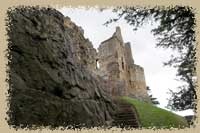 When you enter Dirleton castle, you have the option of walking through the walled garden -- which has, according to the little booklet, the longest herbaceous border in Scotland. It really is quite lovely, although I can't imagine the amount of work it takes to maintain things. The round dovecot at the top of the hill is well preserved (although I can't quite figure out why the little alcoves are made of stone, that would seem to be very, very hard to do). I love the castle itself, though. In the right light, it's a lovely golden color and the huge round towers just seem so "castle-like" that is' hard not to like it. There's even a drawbridge! Well, I'm not sure it actually moves, of course. The warren of rooms and cellars inside are from several different periods, and it's easy to see how the detail and decorations changed through the years.
When you enter Dirleton castle, you have the option of walking through the walled garden -- which has, according to the little booklet, the longest herbaceous border in Scotland. It really is quite lovely, although I can't imagine the amount of work it takes to maintain things. The round dovecot at the top of the hill is well preserved (although I can't quite figure out why the little alcoves are made of stone, that would seem to be very, very hard to do). I love the castle itself, though. In the right light, it's a lovely golden color and the huge round towers just seem so "castle-like" that is' hard not to like it. There's even a drawbridge! Well, I'm not sure it actually moves, of course. The warren of rooms and cellars inside are from several different periods, and it's easy to see how the detail and decorations changed through the years.
Scuttling off to the car as the rain started in earnest, we drove out to the coast to see Tantallon, another of the castles we saw ten years ago. We didn't duplicate too much of our trip, I assure you (I promise, despite the first few days retracing our steps, we really did set off in new and different directions), but some of the castles really are worth another look. Tantallon is one of them -- an absolutely enormous fortress on the coast, faced with huge towers and a curtain wall that rises (xxx) feet. Historic Scotland is working on the gatehouse, repointing the stone and reinforcing the twin towers and entry.
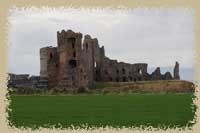 The site is spectacular, dropping off into the sea precipitously and commanding the coastline. It certainly looks every inch the impenetrable fortress (and indeed, was really only ever taken by sea and could be defended with a handful of men). It's worth a climb all the way to the top of the wall -- from up there, you can see the vast earthworks that surround the castle: revets and ditches and mounds that fan out from the main gateway and disappear under the road and farm fields as far as you can see. It can get windy (we ran into a couple up on the top where the husband was trying to dangle himself off the wall to get the perfect picture, while his wife huddled in the corner o the staircase and refused to come out on the wall walk. It's not the place for anyone afraid of heights, I'll give you that, especially when t he wind kicks up. In the other tower, we followed two giggling preschool girls up the stairs and talked with their grandfather -- he was very excited to tell us that he visited the States every year, in the south, and loved the old plantation houses. We laughed a bit over how our view of "old" is a bit skewed, and he assured us that he liked the stately homes better than these 'windy piles". I respectfully disagree, of course - I find the windy piles (and crumbling ones) fascinating!
The site is spectacular, dropping off into the sea precipitously and commanding the coastline. It certainly looks every inch the impenetrable fortress (and indeed, was really only ever taken by sea and could be defended with a handful of men). It's worth a climb all the way to the top of the wall -- from up there, you can see the vast earthworks that surround the castle: revets and ditches and mounds that fan out from the main gateway and disappear under the road and farm fields as far as you can see. It can get windy (we ran into a couple up on the top where the husband was trying to dangle himself off the wall to get the perfect picture, while his wife huddled in the corner o the staircase and refused to come out on the wall walk. It's not the place for anyone afraid of heights, I'll give you that, especially when t he wind kicks up. In the other tower, we followed two giggling preschool girls up the stairs and talked with their grandfather -- he was very excited to tell us that he visited the States every year, in the south, and loved the old plantation houses. We laughed a bit over how our view of "old" is a bit skewed, and he assured us that he liked the stately homes better than these 'windy piles". I respectfully disagree, of course - I find the windy piles (and crumbling ones) fascinating!
I picked up a couple of books in the Historic Scotland shop (and asked questions about the weird bolt-holes in the walls and various room layouts, which the two gentlemen manning the site tried valiantly to answer. In one of the rooms identified as the kitchens, the window had a square hole in one side of the opening, about 8" square, that ran at least three feet into the wall. It looked like a bolt-hole, or putt hole for a beam to lock a door or hold a walkway, but why would it be in the jamb of the window? I asked if the wall had been rebuilt or repurposed, and they were unsure. One of the guys brightly suggested that it was for storing salmon, and we all laughed. Although no one else had a much better idea, I guess.
Hidden castles and repurposed castles
Mark insisted that we start on our way to our B&B for the night (Dunseverick House, on the coast) and I, equally forcefully, insisted on trying to find the two castles that were marked nearby. They were even on the way! We found the little private road to the beach near Auldhame and -- with a bit of detective work -- actually managed to spy the castle, nearly hidden in the trees and (since neither of us had wellies) almost impossible to climb up to. I had a hard enough time slogging my way back up the hill to the car! There may have been a path up there somewhere, but we didn't see it. If we hadn't know that the castle HAD to be there somewhere, we would have missed it entirely.
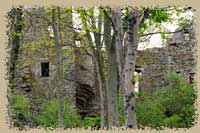 While I tried to pick my way up to the castle for a closer look, Mark kept on down to the beach and discovered a strange, rock-but harbor for someone's boat - it was obviously carved from the stone, with a mechanical lift and stairs down to the water. It was very small, though, and we entertained the idea that it may have been used by smugglers. It certainly would have been a safe place to tie up a boat in bad weather, though. It's possible that this was part of the estate for Auldhame Castle - we found a few remains of the walls and such within walking distance. It's hard to decipher the remains sometimes - I don’t' know enough about them to know if they are more modern additions, or original to the site. And, since most of the castles and towers are continually added on to and repaired, the question of "does this belong?" gets even harder. I usually end up researching thing much later, although Mike Salter's books usually offer a good, quick overview while I'm standing on the site.
While I tried to pick my way up to the castle for a closer look, Mark kept on down to the beach and discovered a strange, rock-but harbor for someone's boat - it was obviously carved from the stone, with a mechanical lift and stairs down to the water. It was very small, though, and we entertained the idea that it may have been used by smugglers. It certainly would have been a safe place to tie up a boat in bad weather, though. It's possible that this was part of the estate for Auldhame Castle - we found a few remains of the walls and such within walking distance. It's hard to decipher the remains sometimes - I don’t' know enough about them to know if they are more modern additions, or original to the site. And, since most of the castles and towers are continually added on to and repaired, the question of "does this belong?" gets even harder. I usually end up researching thing much later, although Mike Salter's books usually offer a good, quick overview while I'm standing on the site.
Only a few miles down the road was Whitekirk and Whitekirk Tower. The tower doesn't look tower-like at all, and my notes say it was originally a tower house, then extended and used as a tithe-barn and fairly recently was restored as a house. I took pictures from the churchyard and didn't venture much further after getting the hairy eyeball from the owner as he arrived home. The church, which lies right against the main road, is an old stone church with a central tower. There wasn't any signage telling me just what church this is, but it incorporates the ruined arches and doorways of a much larger church with a central tower. The level of the churchyard is at least six feet above the level of the road - I stepped up on the church wall to take some pictures and nearly tumbled into the road when I realized how far up I was. Whoops!
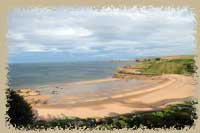 The skies cleared and we got our first dose of real sunshine just as we pulled up to the B&B. The views from the house are spectacular - long sandy beaches, up the rocky coast to St Abbs head; I'm pretty sure that if it had been just a wee bit clearer, we could have seen all the way to Tantallon. Our room is large (and chilly) and faces out toward the beach. The wind is still howling pretty fiercely, so we decided to forgo a walk down to the beach and nap until dinner.
The skies cleared and we got our first dose of real sunshine just as we pulled up to the B&B. The views from the house are spectacular - long sandy beaches, up the rocky coast to St Abbs head; I'm pretty sure that if it had been just a wee bit clearer, we could have seen all the way to Tantallon. Our room is large (and chilly) and faces out toward the beach. The wind is still howling pretty fiercely, so we decided to forgo a walk down to the beach and nap until dinner.
Dinner was lovely - the proprietor did the cooking and we shared a lovely evening with the Swedish couple staying in the other room. Bottle of wine, tasty lamb and scallops. As we sat after dinner, sated and lazy, that walk down to the beach was less enticing than a comfortable bed. We surrendered and fell asleep listening to the wind and the rain hitting the roof.
Our laugh-out-loud moment today? When Mark announced that we needed to find "food! Now!" and that he was "starving to death". I stared at him for a moment, then said slowly, "No, you're obviously starving to crabby. That's much worse!"

